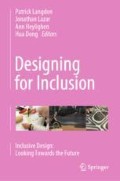Abstract
This paper reports on the interdisciplinary design, development, and implementation of a digital application and database called ‘Innova’ that serves as a platform to collect and analyse assistive technologies (AT) currently available for family/friend carers and consequently also care recipients. AT products/systems/services that support carers (directly or indirectly) in their everyday lives have the potential to serve as precedents to inform innovators to create new AT products/systems/services to better meet the needs of carers. These precedents become ‘materialised design knowledge’ that is a significant kit of information that acts as sources of inspiration for designers. The aim of Innova is to compile and examine information about AT precedents as a precedent-based design (PBD) tool for designers to improve and/or create new AT products/systems/services that better suit carers’ needs. Innova is a digital environment that includes an application and database that can be used on Android smartphones and tablets. The digital application and database have a user-centered survey, a user-interface, and feedback features to collect information about AT precedents.
Access this chapter
Tax calculation will be finalised at checkout
Purchases are for personal use only
Notes
- 1.
AGE-WELL NCE (Aging Gracefully across Environments using Technology to Support Wellness, Engagement and Long Life NCE Inc.) is Canada’s technology and aging network, dedicated to the creation of technologies and services that benefit older adults and carers. Launched in 2015 through the federally-funded.
- 2.
Designers refer to product developers and engineers, industrial designers, graphic designers, and any other innovators who could benefit from PBD.
References
Banga C, Weinhold J (2014) Essential mobile interaction design: perfecting interface design in mobile apps. Addison-Wesley (Pearson Education), Boston
Bharucha AJ, Anand V, Forlizzi J, Dew MA et al (2009) Intelligent assistive technology applications to dementia care: current capabilities, limitations, and future challenges. Am J Geriatr Psychiatry 17(2):88–104
Carers Australia (2015). www.carersaustralia.com.au/about-carers/statistics/. Accessed 18 Dec 2019
Carers UK (2015). www.carersuk.org/news-and-campaigns/press-releases/facts-and-figures. Accessed 2 Aug 2017
Eckert C, Stacey M (2000) Sources of inspiration: a language of design. Des Stud 21:523–538
Heylighen A, Neuckermans H (2001) A case base of case-based design tools for architecture. Comput Aided Des 33(14):1111–1122
Iny C (2018) The best UX tools for user research and user testing, 2019 Edition. UsabilityGeek. 2011–19. usabilitygeek.com/best-ux-tools-user-research-user-testing-2018/. Accessed 16 Dec 2019
Jordan P (2001) An introduction to usability. Taylor & Francis Inc., Philadelphia
Keating N, Eales J (2017) Social consequences of family care: a scoping review. Int J Care Caring 1(2):153–173
Keating NC, Fast JE, Lero DS, Lucas SJ, Eales J (2014) A taxonomy of the economic costs of family care to adults. J Econ Ageing 3:11–20
Levin M (2014) Designing multi-device experiences: an ecosystem approach to user experiences across devices. O’Reilly Media, Inc., Sebastopol
National Alliance for Caregiving and AARP (2015). www.caregiving.org/wp-content/uploads/2015/05/2015_CaregivingintheUS_Final-Report-June-4_WEB.pdf. Accessed 2 Aug 2017
Oxman R, Oxman R (1993) Precedents: memory structure in design case libraries. In: Flemming U, Van Wyk S (eds) CAAD futures 1993. Elsevier Science Publishers, Amsterdam
Oxman R (1996) Case-based design support: supporting architectural composition through precedent libraries. J Archit Plan Res 13(3):242–255
Pollack M (2005) Intelligent technology for an aging population: the use of AI to assist elders with cognitive impairment. AI Mag 26(2):9
Sheets D, Black K, Kaye L (2014) Who cares for caregivers? Evidence-based approaches to family support. J Gerontol Soc Work 57(6–7):525–530
Sinha M (2012) Analytical paper. Spotlight on Canadians: Results from the general social survey. Portrait of caregivers, 2012. Statistics Canada, Ottawa, Canada. www.statcan.gc.ca/pub/89-652-x/89-652-x2013001-eng.pdf. Accessed 2 Aug 2017
Strickfaden M, Stafiniak L, Terzin T (2015) Inspired and inspiring designers: understanding creativity through influence and inspiration. Cloth Text Res J 33(3):213–228
Topo P (2009) Technology studies to meet the needs of people with dementia and their caregivers: a literature review. J Appl Gerontol 28(1):5–37
Acknowledgements
The authors gratefully acknowledge the financial contributions of AGE-WELL NCE Ltd., Canada’s technology and aging network, through the core research project WP2.4 Assistive Technology that Cares for the Caregiver.
Author information
Authors and Affiliations
Corresponding author
Editor information
Editors and Affiliations
Rights and permissions
Copyright information
© 2020 Springer Nature Switzerland AG
About this paper
Cite this paper
Strickfaden, M., Fiorentino, C., Martin, M., Eales, J., Fast, J. (2020). ‘Innova’ Digital Application and Database for Designers to Innovate for Carers. In: Langdon, P., Lazar, J., Heylighen, A., Dong, H. (eds) Designing for Inclusion. CWUAAT 2020. Springer, Cham. https://doi.org/10.1007/978-3-030-43865-4_4
Download citation
DOI: https://doi.org/10.1007/978-3-030-43865-4_4
Published:
Publisher Name: Springer, Cham
Print ISBN: 978-3-030-43864-7
Online ISBN: 978-3-030-43865-4
eBook Packages: EngineeringEngineering (R0)

